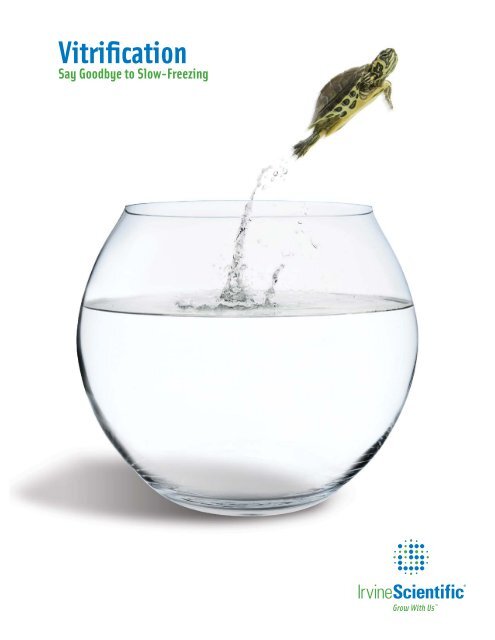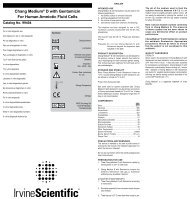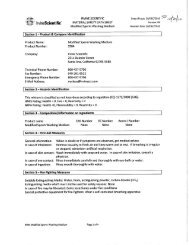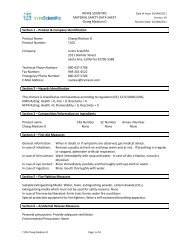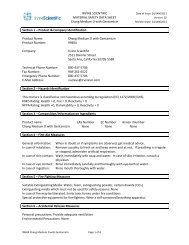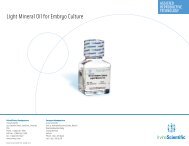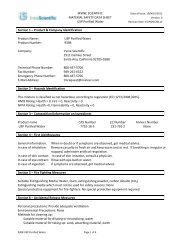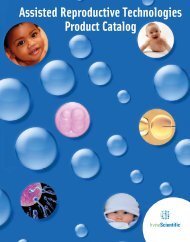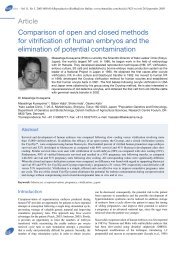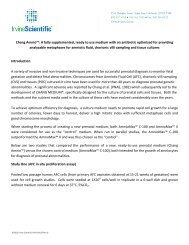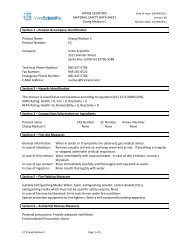Product Sheets | Vitrification Brochure - Irvine Scientific
Product Sheets | Vitrification Brochure - Irvine Scientific
Product Sheets | Vitrification Brochure - Irvine Scientific
Create successful ePaper yourself
Turn your PDF publications into a flip-book with our unique Google optimized e-Paper software.
<strong>Vitrification</strong><br />
Say Goodbye to Slow-Freezing
Benefits of <strong>Vitrification</strong> Vs. Slow-Freezing<br />
Better Pregnancy Rates with Fewer<br />
Embryos Transferred<br />
Multiple pregnancies are the greatest<br />
complication resulting from IVF treatment, and<br />
for many patients transfer of a single embryo<br />
is now recommended. However, this practice<br />
risks an overall lower pregnancy rate per cycle,<br />
when compared to cycles where multiple<br />
embryos are used. But the introduction of<br />
vitrification to clinical practice has the potential<br />
to allow for very reliable recovery of cryopreserved<br />
embryos, giving practitioners and patients more<br />
confidence to transfer fewer embryos in the<br />
fresh cycle.<br />
If pregnancy and implantation rates with<br />
preserved embryos can be shown to be similar<br />
to those with fresh embryos, the need to transfer<br />
multiple embryos in any cycle will be greatly<br />
reduced. Data confirms that excellent pregnancy<br />
rates can be achieved with vitrified blastocysts in<br />
patients of all ages in frozen embryo transfer<br />
cycles, thus allowing clinics to move to elective<br />
Decreased Chilling Injury<br />
Compared to slow-freezing, the rate oocytes<br />
and embryos pass through the dangerous<br />
temperature zones (15 to -5°C) with vitrification<br />
are extremely high, and the very short exposure<br />
to dangerous temperatures radically decreases the<br />
injury of the sensitive structures. 2<br />
Time is Valuable<br />
Instead of spending several hours slow-freezing,<br />
the vitrification process can be completed in 10<br />
minutes, allowing more time to perform other<br />
critical lab tasks.<br />
Minutes until process is complete<br />
200<br />
180<br />
single embryo transfer. 1 0<br />
160<br />
140<br />
120<br />
100<br />
80<br />
60<br />
40<br />
20<br />
<strong>Vitrification</strong><br />
Slow freezing
Reasons to Choose <strong>Vitrification</strong><br />
“WHEN (not if!) IVF programs overcome fear of the unknown, and take on the<br />
challenge of a significant learning curve with vitrification, THEN vitrification will<br />
become the clinical standard for human oocyte and embryo cryopreservation.”<br />
Juergen Liebermann, PhD<br />
Laboratory Director<br />
Fertility Center of Illinois<br />
Chicago, IL<br />
“Here at HRC-Laguna Hills, we switched to vitrification (<strong>Irvine</strong> <strong>Scientific</strong>’s Vit<br />
Kit ® -Freeze/Thaw and CryoTips) as of March of 2007. Since then we have seen a<br />
significant increase in both our embryo survival rates (+35 percentage points)<br />
and our clinical pregnancy rates (+23 percentage points). Biopsied blastocysts<br />
tolerate vitrification better than slow freeze cryopreservation.”<br />
Charlotte Khoury<br />
<strong>Scientific</strong> Director<br />
Huntington Reproductive Center<br />
Laguna Hills, CA
<strong>Vitrification</strong> is Superior to Slow-Freezing<br />
Significantly Improved Pregnancy Rates<br />
with Oocyte <strong>Vitrification</strong><br />
A study published in Fertility and Sterility<br />
compared the cryopreservation of mature<br />
human oocytes by either slow-rate freezing<br />
or vitrification (<strong>Irvine</strong> <strong>Scientific</strong> Vit Kits with<br />
CryoTips) to determine which method is the<br />
most efficient at establishing a pregnancy. 3<br />
Significantly Higher Survival Rates<br />
with Oocyte <strong>Vitrification</strong><br />
The outcome of a study on oocyte vitrification,<br />
conducted at the Cryobiology Unit at Instituto<br />
Valenciano de Infertilidad (IVI), was published<br />
in RBMonline to evaluate the influence of four<br />
different cyropreservation protocols on freshly<br />
collected human oocytes. 4<br />
Figure 1. Oocyte Survival and Functionality Following<br />
Cryopreservation by Slow-Rate Freezing/<br />
Thawing or <strong>Vitrification</strong>/Warming (Smith et al., 2010)<br />
100<br />
90<br />
80<br />
70<br />
60<br />
50<br />
40<br />
30<br />
20<br />
10<br />
0<br />
100<br />
90<br />
80<br />
70<br />
60<br />
50<br />
40<br />
30<br />
20<br />
10<br />
0<br />
# thaw cycles % survival<br />
P < 0.001<br />
Cleavage rates<br />
P < 0.01<br />
% biochemical pregnancies/<br />
thaw or warming cycle<br />
P < 0.01<br />
<strong>Vitrification</strong><br />
Slow freezing<br />
% fertilized<br />
P < 0.03<br />
<strong>Vitrification</strong><br />
Slow freezing<br />
% clinical pregnancies/<br />
thaw or warming cycle<br />
P < 0.02<br />
<strong>Vitrification</strong>/warming resulted in significantly<br />
higher cryosurvival, fertilization, embryo cleavage<br />
and development and clinical pregnancy rates in<br />
comparison to slow-rate freezing/thawing.<br />
Table 1. Survival of Oocytes After Cryopreservation<br />
(Cobo et al., 2008)<br />
Cryopreservation<br />
protocol<br />
Slow freezing +<br />
0.2 mol/l sucrose<br />
Slow freezing +<br />
0.3 mol/l sucrose<br />
Slow freezing +<br />
choline replacement<br />
<strong>Vitrification</strong> by<br />
CryoTip ® method<br />
No. of<br />
oocytes<br />
36<br />
34<br />
36<br />
27<br />
No. surviving<br />
(%)<br />
23<br />
(63.8) a<br />
25<br />
(73.5) b<br />
20<br />
(74.1)<br />
20<br />
(86.9) a,b<br />
Control (fresh oocytes) 34 34<br />
Total 167 122<br />
a,b Values with the same superscript letter are significantly different (P
Visual Demonstration of Post-<strong>Vitrification</strong> Survival<br />
Improved Embryo Survival<br />
with <strong>Vitrification</strong><br />
By avoiding intracellular ice formation<br />
associated with slow-freezing, vitrification<br />
minimizes embryo damage.<br />
Photo Courtesy of Juergen Liebermann, PhD, Fertility Center of Illinois.<br />
Embryo Quality Appears<br />
Unchanged Post-<strong>Vitrification</strong><br />
Thawed blastocysts that have undergone<br />
vitrification look identical to fresh<br />
blastocysts, indicating that human embryos<br />
tolerate vitrification well.<br />
Fresh Human Blastocysts<br />
Vitrified/Warmed Human Blastocysts<br />
Photos Courtesy of Juergen Liebermann, PhD, Fertility Center of Illinois.
Selecting Cryoprotectants<br />
DMSO-Containing <strong>Vitrification</strong> Solutions<br />
Ice-crystal formation that is associated with<br />
slow-freezing can be lethal to oocytes and<br />
embryos. Cryoprotectants, both permeating and<br />
non-permeating, are used to reduce ice-crystal<br />
formation by dehydrating the cells before the<br />
vitrification process. All cryoprotectants are<br />
potentially hazardous. The hazards associated<br />
with cryoprotectants can be greatly minimized<br />
by using a combination of cryoprotectants<br />
at reduced concentrations, limiting the time<br />
of exposure, and using a proven method that<br />
allows for rapid vitrification.<br />
Dimethylsulfoxide (DMSO) and ethylene glycol<br />
(EG) are the most widely used permeating<br />
cryoprotectants in vitrification solutions for<br />
human oocytes and embryos, while sucrose<br />
is the most commonly used non-permeating<br />
cryoprotectant.<br />
Figure 2. Comparison of Protocols A (with DMSO)<br />
and B (without DMSO) in Mouse (Kartberg et al., 2008)<br />
% survival (reach blastocyte stage after 49 h)<br />
100<br />
90<br />
80<br />
70<br />
60<br />
50<br />
40<br />
30<br />
20<br />
10<br />
0<br />
0 5 10 15<br />
Time in vitrification solution (min)<br />
Protocol A (with DMSO)<br />
Protocol B (without DMSO)<br />
20 25 30<br />
A study investigating the chemical injury<br />
associated with vitrification showed that the<br />
DMSO-containing vitrification solution leads<br />
to significantly less chemical injury upon<br />
prolonged exposure compared with the DMSOfree<br />
vitrification solution, possibly due to the<br />
fast penetrating characteristics of DMSO. 5
An Optimized <strong>Vitrification</strong> System<br />
<strong>Irvine</strong> <strong>Scientific</strong> Vit Kits contain a combination of two permeating<br />
cryoprotectants (DMSO and EG) and sucrose as the non-permeating<br />
cryoprotectant. These solutions provide optimal concentrations with a<br />
proven protocol that requires short exposure times to solutions at favorable<br />
temperatures, consequently enabling rapid vitrification when plunged into<br />
liquid nitrogen without the formation of ice crystals yielding higher survival<br />
and pregnancy rates than those for slow-freezing.
Being a pioneer that has made vitrification commercially available<br />
to IVF clinics worldwide since 2005, we’ve had the privilege of<br />
working closely with hundreds of embryologists across the world<br />
as they adopted vitrification into their practice. As a result, we<br />
have learned a great deal from our customers about some of the<br />
practical challenges and solutions that go along with adopting<br />
a new technique such as vitrification. This unique insight gives<br />
us the ability to support your transition and continued success<br />
with great confidence that only comes with years of experience.<br />
Our skilled technical application scientists and customer service<br />
representatives are an extension of our products that are at your<br />
disposal as you, too, say goodbye to slow-freezing.
Advantages of <strong>Irvine</strong> <strong>Scientific</strong> <strong>Vitrification</strong> Kits<br />
Convenient Kits<br />
• Unique packaging identifying<br />
each component resulting in quick<br />
identification and efficient use<br />
• Available with just media to<br />
support any cryodevice<br />
• Available with a cryodevice:<br />
CryoTip ® or HSV Straw<br />
Regulatory Compliant<br />
• CE marked media for<br />
gametes and embryos<br />
• FDA cleared media for<br />
embryos of all stages<br />
• CryoTip ® is CE marked<br />
and FDA cleared<br />
• HSV Straw is CE marked<br />
Eight Week Shelf-Life After Opening<br />
• Longer shelf-life than other<br />
commercially available kits<br />
• Save time and money by<br />
ordering less often<br />
Simple, Straight-Forward Protocols<br />
• Easy to learn and perform<br />
• Removes uncertainty when training<br />
Outstanding Customer Support<br />
• Knowledgeable staff on hand to<br />
support your technical needs<br />
• Available to assist you with accurate<br />
and on-time order processing<br />
• Committed professionals who strive<br />
to establish lasting relationships<br />
Kits Provide Multiple Applications<br />
• Can be used on more<br />
than one patient<br />
• Less waste and more costeffective<br />
than other kits that are<br />
single patient, single usage
<strong>Irvine</strong> <strong>Scientific</strong> Media for <strong>Vitrification</strong><br />
Media Composition<br />
The composition of these solutions is based<br />
upon published methods and designed in<br />
collaboration with Dr. Masashige Kuwayama<br />
utilizing a combination of EG and DMSO<br />
as the permeating cryoprotectants. The basal<br />
medium for these solutions is Modified<br />
M199 (containing 21 mM HEPES buffer)<br />
supplemented with 20% DSS (HSA and<br />
Dextran, containing 10 mg/mL protein) and<br />
35 µg/mL gentamicin as the antibiotic.<br />
Solution DMSO (v/v) EG (v/v) Sucrose<br />
Equilibration Solution (ES) 7.5% 7.5% 0<br />
<strong>Vitrification</strong> Solution (VS) 15% 15% 0.5M<br />
Thawing Solution (TS) 0% 0% 1.0M<br />
Dilution Solution (DS) 0% 0% 0.5M<br />
Washing Solution (WS) 0% 0% 0<br />
Vit Kit ® Configurations<br />
Available configurations for USA<br />
Vit Kit ® – Freeze (for embryos – 2PN through blastocyst)<br />
Order No: 90133-DSO<br />
Contents: ES 2x1 mL, VS 2x1 mL<br />
Vit Kit ® – Thaw (for embryos – 2PN through blastocyst)<br />
Order No: 90137-DSO<br />
Contents: TS 4x1 mL, DS 1x1 mL, WS 1x2 mL<br />
Available configurations Worldwide (excluding USA)<br />
Vit Kit ® – Freeze (for oocytes and embryos of all stages)<br />
Order No: 90133-HSV<br />
Contents: ES 2x1 mL, VS 2x1 mL, 8 HSV Straws<br />
Order No: 90133-SO<br />
Contents: ES 2x1 mL, VS 2x1 mL<br />
Vit Kit ® – Thaw (for oocytes and embryos of all stages)<br />
Order No: 90137-SO<br />
Contents: TS 4x1 mL, DS 1x1 mL, WS 1x2 mL
Devices for <strong>Vitrification</strong><br />
<strong>Irvine</strong> <strong>Scientific</strong> provides flexibility by offering two closed system devices. Clinical<br />
data on blastocyst stage embryos with <strong>Irvine</strong> <strong>Scientific</strong> media is presented for both<br />
the CryoTip ®6 and the HSV Straw. 7<br />
CryoTip ®<br />
The CryoTip® is a finely pulled straw designed<br />
for holding gametes or embryos during<br />
cryopreservation procedures and long-term<br />
frozen storage. This closed-system device is<br />
widely used by fertility clinics around the world.<br />
Figure 3. Clinical Data on <strong>Vitrification</strong> with <strong>Irvine</strong><br />
<strong>Scientific</strong> Media and the CryoTip ® (Conaghan et al., 2010)<br />
1200<br />
1100<br />
1000<br />
900<br />
800<br />
100<br />
90<br />
80<br />
70<br />
700<br />
60<br />
600<br />
50<br />
500<br />
40<br />
• Metal sleeve to protect the tip and<br />
specimens during storage<br />
• 510k cleared<br />
• CE marked<br />
• Closed system<br />
400<br />
300<br />
200<br />
100<br />
0<br />
# cycles # blastocysts # embryos<br />
transferred<br />
30<br />
20<br />
10<br />
0<br />
% survival Implantation<br />
rate<br />
% clinical<br />
pregnancies<br />
HSV Straw<br />
The HSV Straw is a completely closed system<br />
when thermally sealed using the SYMS sealer<br />
resulting in complete containment of vitrified<br />
specimens.<br />
Figure 4. Clinical Data on <strong>Vitrification</strong> with <strong>Irvine</strong><br />
<strong>Scientific</strong> Media and the HSV Straw (Liebermann el al., 2010)<br />
1200<br />
1100<br />
1000<br />
900<br />
800<br />
100<br />
90<br />
80<br />
70<br />
700<br />
60<br />
600<br />
50<br />
• High quality ionomeric resin straw<br />
• Available in six different colors<br />
to aid in traceability<br />
• CE marked<br />
• Closed system<br />
500<br />
400<br />
300<br />
200<br />
100<br />
0<br />
# cycles # blastocysts # embryos<br />
transferred<br />
40<br />
30<br />
20<br />
10<br />
0<br />
% survival Implantation<br />
rate<br />
% clinical<br />
pregnancies
Quality Testing<br />
Each lot receives a complete laboratory evaluation<br />
including mouse embryo testing, endotoxin level,<br />
pH, osmolality and sterility testing. All results are<br />
provided in a lot-specific Certificate of Analysis.<br />
<strong>Irvine</strong> <strong>Scientific</strong>’s commitment to excellence<br />
is demonstrated by its products’ performance<br />
and adherence to the industry’s highest quality<br />
standards. <strong>Irvine</strong> <strong>Scientific</strong> was the first ART<br />
manufacturing company in the USA to receive<br />
ISO 13485:2003 quality systems certification, the<br />
rigorous international quality assurance standard<br />
designed specifically for Medical Devices.<br />
<strong>Product</strong>s manufactured by <strong>Irvine</strong> <strong>Scientific</strong> are<br />
produced in accordance with the Guidelines for<br />
Manufacture of In Vitro Diagnostic <strong>Product</strong>s and<br />
the Good Manufacturing Practices (GMPs) for<br />
Medical Devices.<br />
References<br />
1. Conaghan et al., (2010), Human blastocyst <strong>Vitrification</strong> and<br />
Warming: 3 Years Experience Using the CryoTip®<br />
2. Tucker M, Liebermann J, (2007), <strong>Vitrification</strong> in Assisted<br />
Reproduction. United Kingdom. Informa Healthcare<br />
3. Smith et al., (2010), Prospective randomized comparison of human oocytes cryopreservation<br />
with slow-rate freezing or vitrification, Fertility and Sterility, Feb 18 2010<br />
4. Cobo et al., (2008), Effect of different cryopreservation protocols on the metaphase II<br />
spindle in human oocytes, Reproductive BioMedicine Online, Volume 17, 16 July<br />
5. Kartberg A-J et al., (2008), <strong>Vitrification</strong> with DMSO protects embryo membrane integrity better<br />
than solution without DMSO, Reproductive BioMedicine Online, Volume 17, 3 September<br />
6. Data on file.<br />
7. Data on file.<br />
North America Headquarters<br />
<strong>Irvine</strong> <strong>Scientific</strong><br />
2511 Daimler Street, Santa Ana, CA 92705<br />
USA<br />
Phone: 1 (949) 261-7800<br />
Toll Free: 1 (800) 437-5706<br />
Fax: 1 (949) 261-6522<br />
www.irvinesci.com<br />
2012 <strong>Irvine</strong> <strong>Scientific</strong> P/N 10034R Rev.11<br />
Europe Headquarters<br />
<strong>Irvine</strong> <strong>Scientific</strong><br />
Unit 31, Newton Business Center, Block D<br />
Newtownmountkennedy<br />
County Wicklow<br />
Ireland<br />
Phone: +353 1 281 99 20<br />
Fax: +353 1 281 99 28<br />
Asia Headquarters<br />
<strong>Irvine</strong> <strong>Scientific</strong><br />
3-17-35 Niizo-Minami<br />
Toda-Shi<br />
335-0026 Saitama<br />
Japan


